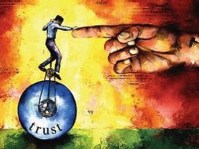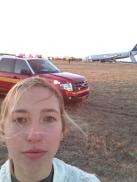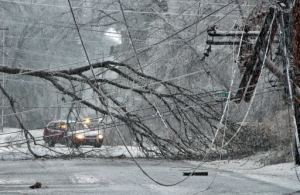Blog Archives
Preparedness sounds like momsense…
I can’t apologize for my pitiful puns. Or won’t…maybe it’s won’t?
This month I’ll be joining other preparedness-minded moms in discussing some of the most important topics America’s PrepareAthon has to share. While I was preparing my little section of slides (chatting about communication, surprise surprise!) I really had to take a minute to wonder, what do other moms need to hear that makes them truly take a step in preparing their family? Better yet, how can those steps be as feasible as possible?
If you work in preparedness and connect to the community at any point, I’m sure you’ve wondered this yourself. Let me share with folks what doesn’t work. Moms, dads, family members, feel free to chime in in the comments section.
This Doesn’t Work
- Acronyms
- Bestowing ALL of the information you know upon others
- Anything where you mention a directive, presidential and otherwise
- 10,000-foot-tall fear tactics
- Information that requires training to understand
These things don’t work because they don’t matter to anyone outside of the field. If you’re not in the preparedness business, all you need to know is what will keep you and your family safe, and the time and financial cost of it. Nobody disagrees they’d like to be prepared during an emergency or disaster, but if we’re all going to live like “that will never happen here”, we have to know that preparing for it is worth the effort.
This Does Work
- Reasons that what you’re saying is important
- Free things
- Easy things
- Plans that also improve daily life
- Simple, relatable language
- Realistic examples
- Understanding who you’re talking to
Some of us enjoy a family game night, movie night, standing dinner, Sunday drive. My family and I enjoy lots of those things, but we also enjoy family preparedness. I know, it sounds like I made that up just so you’d listen to my blog and trust my opinion. But hearing my kids process what they think is safe and smart, giving me their feedback on where our family meeting spot should be if we have a house fire, taking a few moments in the car during a bad storm to talk about sheltering, or teaching them a song that helps them remember my phone number – these are things that bring us really close together. I continue to be amazed by the way they see the world and in turn, I don’t fear their safety the way I would if I sent them out in to it completely unprepared.
So fellow emergency management folks, let’s communicate with the community the way they need to hear it, not the way we want to say it.
Fellow moms (and family members, et al), bare with us while we share something that is desperately important to us, to help us all reach our goal of keeping our families safe. After all, it takes a village…
If you’ll be joining me on this webinar, I’ll have 7-10 minutes of solid reasons why you need a communications plan, how to create one and how to make it successful. Don’t wait! Register for the webinar!
What an EM Needs to Know During Ebola
Ebola. Are you tired of hearing about it yet? Not that it isn’t a notable virus that deserves our attention and our preparations, but as emergency managers, our job right now is not to eliminate the threat. Our job right now has very little to do with the actual virus itself. Allow me to make a case for you.
This blog just got serious…
Ebola is a virus that is spread through contact of the bodily fluids of an infected person. It’s not in the air and to get it, you’d have to have a direct exposure that allowed for entry into your own body. Once you’ve got it, yeah, that’s a problem. But in many places, especially the US, actually catching the disease? That is not going to be easy.
Lots of viruses are spread this way and our hospital systems are not only prepared, trained and ready for what’s already here, they’re prepared for what’s coming. Personal protective equipment exists to build a barrier between our healthcare workers and those who require their services. Processes and procedures have been in place to handle the worst of the worst for years on years. So, why then all the fuss, and what are emergency managers actually supposed to be doing with this?
We already know that people fear what they don’t know, and that there are so many unanswered questions about the disease itself is the worst kind of unknown. Where does it originate? Can it mutate? Why isn’t there a cure? I get it – I find these questions intriguing myself!
Right now, however, our job isn’t to answer these questions. Our job lies in the public panic. I would estimate that is roughly 85% of our responsibility since the beginning of disease spread. Of course there is training, drills, exercises and inter-agency communication to be done, but the major focus simply must be on communicating clearly with the public. Most essentially on a local level. Why? Because the public has a disconnect in personal trust on a federal level.
And why shouldn’t they? They don’t “know” federal departments. Federal agencies aren’t first responders, and they’re more often than not separated from the local message and response. They have a huge task before them (i.e answering those questions above that we aren’t challenged to solve), but they won’t be able to truly touch public panic and public perception.
As emergency managers, it isn’t our job to answer the questions of the specialty agencies we support. What we need to focus on is developing a consistent, calming, accurate message from our partner agencies to our community members, because their perceptions and their unnecessary panic is the emergency right now.
Those plans you’ve worked so diligently on? People need to know they exist. Those exercises you participate in? People need to know that they happened. We can’t answer the questions that make people so afraid, but we can keep fear from turning into panic by showing all of the ways we have always been prepared and we will continue to be prepared. Our community members need to hear from us that we have a plan, that they can trust we know what we’re doing. And we need to be trusted enough to explain how these scary things work, and what we’ll do about it.
It won’t be enough to go out and tell everyone they have nothing to worry about. Let’s face it, that message ain’t gonna cut it! It’s okay to allow our community members to feel something. But when was the last time a scare tactic changed anything about anyone’s actual preparedness status? Go ahead, I’ll give you some time to think about it…
Scare tactics don’t work. We need to communicate all of this, take away the element of panic, and turn relevant concern into beneficial action.
Explaining what we do, having a consistent presence, facilitating that message and then showing people that just as we have prepared ourselves for the worst of the worst, so too can they prepare, is where the success is. Our plans don’t fall to the wayside because they’re flexible enough to fit the different disasters we face. Our plans, kits and equipment are adaptable. Anyone’s can be, if they know where to start.
Here’s the catch…it really only works if your community has faith in your message.
Do you exist outside of the walls of your office? Does your agency know you, does your community know you? Are you equipped to lead the message our public needs to hear, or will you be out of touch? And, for those of you who dread the role of the public information officer, that doesn’t mean being the man or woman on camera. That means being a part of the development of the message and being a trusted source people can turn to in order to successfully receive it.
What have you done to create a trustworthy atmosphere in your community in advance of times like these where our success relies so heavily on our ability to share critical information? Are you prepared for what happens if the community doesn’t hear us and panic does ensue?
Right now is the right time to get ahead of your message, and if you already are, it’s a great time to tell someone else how you’re nailing it.
Go ahead. I’ll wait.
November Disaster in Place – Winter Storms!
It’s time for a new “Disaster in Place”. Take 5-10 minutes to play along!
This month’s scenario is just in time…winter storms.
If severe winter weather were to affect your area right now, what would you do? Could you safely shelter in place at work or at home through the next few nights? What if you lost power and needed to find creative ways to stay warm and cook food, how would you do it? What if…you were stranded in your car for hours in the cold, do you have what you need to stay warm and safe already in there?
For information about prepping your home, car, and mind for severe cold and winter storms, check out this FEMA site and “Pledge to Prepare”: http://www.ready.gov/winter-weather
For a few tips about what to do if winter weather strands you in your car, check out this short (1:46) video: http://www.youtube.com/watch?v=cR9sJKdsY4o
For tips about cooking food, as well as some great non-perishable recipes for your kit, check out: http://www.emergencykitcookoff.org/
All signs point to a busy winter for Virginia…please be prepared!
Tanya
Try this: Disaster in Place!
There aren’t a lot of jobs that require everyone’s participation. And not just everyone in a certain facility or agency, I mean everyone. It’s tough sometimes! I certainly find myself “silo-ing” people into their jobs. I don’t know how to be engaged and I’ll never need to know how to be engaged. I think in the emergency world we find a lot of the same thing. We have jobs to do and whether people know we exist and what our jobs are, they expect they’ll be done and all will be well.
But it just takes more than that.
Working with professionals who have volunteered their time, I am now much more accustomed to adjusting to individuals who don’t think of emergency management on any type of regular basis. It’s kept me from having tunnel-vision or becoming so immersed inside an emergency management world that I forget how to relate with the public. (It’s also done wonders for this fast-talking acronym lover! To slooooow down, spell things out, give meaning to each word of our accurately/overly descript titles!)
Couldn’t have said it better, public health memes!
That being said, I know no matter how many disasters happen, and no matter what has actually impacted our area, encouraging people to think about disasters and preparedness on a realistic level is still a challenge. This is true for community members, colleagues in all types of organizations, schools, and so on. But I think I might have a solution that will help engage people using the best ally we have in preparedness: their minds! ♫Dun dun dun!!♫♪
As an emergency management addict – yes, I’ll admit it – I live thinking about the “worst case scenario” every day. Behind a truck with a radioactive symbol on the highway? I’m planning. Driving through gasoline storage tanks? Planning. Standing at the edge of the ocean? Planning! Random zombie apocalypse in Wal-Mart? Oh, you know I’m planning. I’m sorry, but no disaster scenario you throw me into is going to be as colorful as my “what if…”
So I wonder, what will the public’s “what if’s” do for them?
This month, I will begin a new series with my awesome Medical Reserve Corps teams and leave it open for adaptation in any facility that would like to play off of it. It’s called Disaster in Place and will be more than just a tool to raise “alert” response numbers (those availability responses I monitor when I send out events, tests, etc.) For example, for the month of May, I have scheduled to send out alerts to all three of my units on Tuesday during standard business hours on an Active Shooter scenario. However, the scenario won’t be mine to write.
It will begin with the explanation of Disaster in Place, the purpose and the instructions on how to successfully complete it. (For those of you that may want to replicate this idea, what I’m more or less using is below.) But I won’t leave my friends without some educational resources as well! Months ago, after the Aurora, CO shooting, I encouraged my members to take FEMA’s IS 907 Active Shooter: What You Can Do and we had some interest. But talking yourself through your own active shooting plan, right where you are at that very moment? That may encourage a little more planning indeed. I will also include a link previously shared on some of our Facebook sites, Houston’s popular RUN. HIDE. FIGHT. video on YouTube is a very clear, useful way to consider your choices in an active shooting incident.
The purpose is to leave our members feeling ready (and maybe even the people around them, if word spreads!). Not to live in fear, but to live in preparedness. To create strong, powerful communities where everyone is a part of my job and that’s what makes it successful. Disaster in Place will have several elements I think are critical for success – giving our communities something they can think, something they can see, and something they can do.
Next month, we’ll give severe weather a shot one evening or on the weekend! And once that catches on, I think letting people choose the time/place of that days drill will be appropriate and even more engaging. Stay tuned and I’ll update how it goes, and if you decide to participate, please comment, or shoot me an email and let’s share some great ideas.
Tanya
Want to implement Disaster in Place in your organization? Here’s a snapshot of what’s cooking in my MRC’s:
Purpose: To engage non-emergency management related personnel at least once a month in their normal environments in order to increase awareness, personal preparedness and readiness. (MRC specific purpose: to also increase our alert response and stay actively connected to our members.)
Introduction: Our introduction looks a little something like this…
Good afternoon team,
This month we will begin our Disaster in Place series, designed to increase awareness, preparedness and response no matter what your environment today may be! Please take five minutes to participate in the exercise, and respond to this alert with a “yes” or “no” that you have done so. Please respond either way so we may track our alert response rate, even if you are not able to participate.
This month’s scenario is an Active Shooter event. Please take two minutes to review your surroundings where you are right now. What are your exits? Where are your hiding spaces? What resources, such as phones, windows, and other people are around you? Now take three minutes and decide, what would you do if an active shooter were to advance towards your area?
For tips on what you can do in an event like this, please review the following 5:22 video: Run. Hide. Fight.
For additional FEMA training, please advance to the following course at your leisure and forward your certificate to your coordinator, if you choose to participate.
Thank you for all that you do!
Goal: To require as little time as possible in order to encourage participation – professionals are busy! But in the end, you make time for what you care about, and I believe our members will do just that. We’re asking for a five minute interlude in their day, we’re offering several more minutes of optional training, with an unlimited potential community value.
That’s…A Bad Plan
Ever heard someone say, “In a real emergency, plans go out the window!” I’ve heard it a million times…and I hate it. If your plan hasn’t been written applicably, that’s…a bad plan. If it hasn’t been exercised with you staff and stakeholders, it’s useless. If your plan isn’t engrained into your organization to the point of being second nature, you’ve got work left to do.
I’ve heard time and again that, “noone is going to do that,” in an emergency. I used to shrug and think well, that’s true. Who’s going to have time to make this call or commit to that action, in a real emergency? But I finally understand, I have been giving excuses to something that really doesn’t deserve them.
It seems many EM folks have been looking for ways to get around plans for years. Why? Incident Command gives us a clear direction on who does what, when and how. Yet we fight against this, and all plans, constantly. Allow me to elaborate.
Some time ago I participated in a discussion about triage. Folks were discussing ways to triage and track patients and instead of thinking of consistent, reliable plans, they decided on behalf of “triagers” that they were unchangeable, unwilling or incapable. It became impossible to make a plan because instead of considering what was needed, we left with a nice idea and an “understanding” we’d never actually do it.
Another example: in a discussion about sharing information, everyone bypassed the Liaison Officer concept and the usage of a Public Information Officer, opting to contact whomever was in their address book because “you can’t rely on this agency to contact that agency to let them know what’s going on.”
Please understand, I am thoroughly impressed at the robust network many have established, but, if that person gets hit by a bus before a disaster, I need to know I’m going to know what I need to know. I need to trust that a specific role has a function, understands it and completes it. Networking is invaluable, but I can’t create a plan out of anyone’s personal network, because I can’t create a plan only one person can follow.
So…why write impossible things we only plan to bypass? I submit to you that any plan that causes you to make up your own on the spot or leaves you lacking any faith in it, is….a bad plan. Train your staff or change your plan, either way it needs to work.

And now boys and girls, a story!
Have you ever been to the fast food chain Wendy’s and noticed the square hamburger pattys and wondered why? The founder of Wendy’s, Dave Thomas, built his company on the motto that, “We don’t cut corners on quality.” He left the hamburger corners there as a reminder to his staff and to his consumers that this was their underlying value. True story!
Friends, colleagues, it’s time we stop cutting corners too. Let’s make the corners work, let’s get efficient, let’s get applicable, and let’s leave those corners there for our staff and our consumers to be reminded we’re here to give our best everyday.
Let’s stop writing plans we don’t even believe we’ll use, because if we don’t believe what we’re saying, it is highly improbable anyone else will either.
Why Do Zombies Work?
A friend told me recently that nobody is going to pay attention to emergency preparedness unless we give them a reason to care (in so many words). And I have to say, truer words may never have been spoken. The funny thing is, everything that can actually happen seems to never motivate people into action. In reading Amanda Ripley’s The Unthinkable, history often shows us that even when disasters are actually happening right then and there, people seem to sink into a state of denial. So that really begs the question…why do zombies work?
I have this theory. Preparedness is boring, response is exciting. And the idea of fending for yourself in a cataclysmic event seems to be strangely attractive. Cracked.com came up with a great list of reasons we secretly want the zombie apocalypse (Note: Rated PG-13) that I can’t say I disagree with. The alluring factor of having nothing that stands between you and imminent danger is shocking to me, and yet I am subject to it.
Ask someone what they’ll do in a floodplain, tornado warning, or terrorist attack and they may shrug and mutter something about shelters or insurance. Ask them what they’ll do in a zombie apocalypse? They’re likely to pull out one of these gems (courtesy of zombieinitiative.org):
The key to my theory is this: no one is going to rescue the public in a zombie apocalypse and they know it.
In an apocalypse, it’s every man for themselves. If you know nobody is coming to rescue you, instinctually, you can only plan to rescue yourself. Meanwhile, the public often misunderstands their safety or places an extreme sense of trust into whomever they believe is supposed to protect them and that this agency will follow through. Not that we don’t warrant some trust, but the care of each and every individual is a task that we simply lack the resources to fully meet in a certain events. Why prepare for something you believe you will always be protected from? (Of course my question – why risk it in real life?) We’re all subject to zombieism!
Another key, in a disaster, everyone believes they will know that it’s coming.
Warnings will appear and they’ll have “plenty” of time to get ready. But zombies? Those suckers just arrive. In the movies, there is always someone waking up suddenly out of a coma and the world is overrun. There’s no time to think, only time to act. I’d venture to say people believe they will always have the luxury of knowing in “plenty” of time when something bad is going to happen. But that doesn’t always seem to make a difference anyway, as noted when a local to me river flooded and everyone parked near it just decided, “it won’t happen to me!”
Like I said, response is exciting, and I offer that it’s action movies and shows that have turned this super bad actionista/actionisto idea into something sexy. Even popular zombie shows like The Walking Dead have over 1.4 million Twitter followers and not a day goes by that #zombies isn’t a trending topic of some sort. In addition, they have over 16.4 million “likes” on Facebook, and over 2.4 million people talking about them at any given time. Millions of people who have no doubt questionned their own response in the apocalypse…millions of open minds. And there’s something creatively motivating about recognizing the direness of such a situation and realizing you will have no time, no warning, and no one to save you.
In today’s world, the farther we get from a disaster, the more complacent we become. And that’s whether you experienced it first hand or from afar. Rememer the slew of funding we received after 9/11? I think we’ve all noticed that’s significantly dwindling. And with every day that passes that we remain protected, lucky, or blissfully unaware, emergency funding is displaced and fire chiefs, town managers, or some other unprepared soul is “voluntold” to accept responsibility for planning. Without the tools and training. What happens next? Another big event with potential for major loss of life and property, more funding comes, years go by without an incident, complacency sets in, funding decreases, and so on and so forth.
Tthe CDC had it right. People care about zombies. For whatever reason, whatever theory. You just can’t beat the “what if…” in someone’s mind. But maybe, if we guide it a little bit, we’ll start really talking about preparedness, and maybe have a little fun, too.








